Thinking of switching to a battery leaf blower to help the planet? It seems like the obvious green choice. However, research reveals that battery leaf blowers are bad for the environment. Our exposé explores lithium-ion’s underbelly.
Both gas and battery-powered leaf blowers hurt the environment. However, the mainstream media rarely covers the ills of lithium-ion. Wanting to help Mother Nature thrive, we took a deep dive. In short, we found that battery blowers are far from eco-friendly.
7 Sins of Battery-Powered Leaf Blowers:
- Creating Copious Carbon
- Wasting Water
- Erasing Eco-systems
- Harming Humans
- Dastardly Disposal
- Blown Benefits
- Li-ion Lies
1. Battery Leaf Blowers’ Carbon Footprint

Making battery leaf blowers means mining minerals. Chinese factories turn these raw materials into batteries, then ship them overseas. This creates a catastrophic carbon footprint, summarized in the table below.
| CO2 Emissions (kg) | |
| Mining: 1 tonne of Lithium | 15,000 |
| Producing: 1.5 kWh Li-ion battery | 150 – 1,500 |
| Shipping: China to US | 115 – 5,700 |
| Charging: 1.5 kWh Li-ion battery | .55 |
Mining Monstrosity: The Environmental Impact of Lithium Mining
Battery leaf blowers run on Lithium-ion (Li-ion) batteries.These batteries are made from minerals, including lithium (Li), cobalt (Co), and nickel (Ni). Mining these minerals requires gas-guzzling heavy equipment. As a result, mining 1 tonne of lithium produces approximately 15 tons of carbon dioxide (CO2) emissions.
Combustion Production: China’s Coal-Powered Battery Production
As the largest stakeholder in the lithium-ion industry, China has a heavy-hand in making battery leaf blowers:
- China owns 80% of cobalt mines
- China produces 80% of lithium chemicals
- China produces 78% of battery cathodes
- China produces 77% of Li-ion batteries
- Chinese-owned BYD is the world’s largest Li-ion manufacturer
- China produces most of the parts used to make battery leaf blowers
- Chinese companies (or their subsidiaries) make many of the most popular cordless electric leaf blowers.
Producing energy with coal emits twice as much CO2 as natural gas. With over 60% of China’s power coming from coal, their production plants poison our planet with plentiful pollution.
| Country | % of energy from coal |
| China | 61% |
| Japan | 30% |
| Germany | 26% |
| U.S. | 9% |
| Switzerland | 0.3% |
Fueling Freight: Shipping Lithium-ion Yard Tools
Since most battery leaf blowers are from China, shipping guzzles a lot of gas. A cargo ship emits 115 to 455 kilograms of CO2 on the journey, while a plane produces about 5,700 kilograms of CO2.
Purchasing Parts: The Lifespan of Cordless Electric Leaf Blowers
By buying a battery leaf blower, you enter into a lifelong cycle of purchasing batteries and blowers:
- Over time, Li-ion battery runtime decreases. Then, after 2 to 5 years, leaf blower batteries need replacing.
- Electric leaf blower repairmen are scarce. Even after minor damage, the blower is often discarded and replaced.
- Even when repaired, the parts are likely shipped from China.
Elevating Electric Emissions
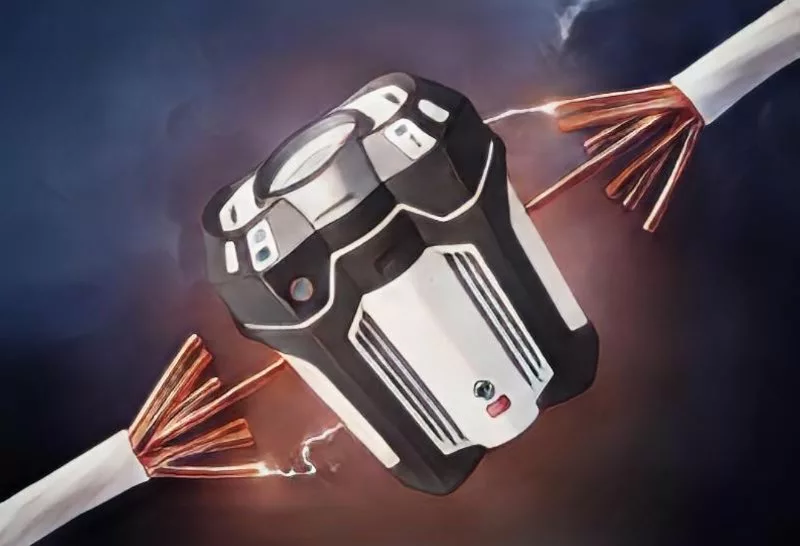
Electricity isn’t emissions-free. According to the EPA, electricity produces 30% of America’s carbon emissions and 24% of all our greenhouse gases. The U.S. Energy Information Administration found that each kilowatt of electricity averages 367.41 grams of CO2 emissions.
| Storage Capacity (kWh) | CO2 (approx. grams) |
| .05 | 18 |
| .1 | 37 |
| .25 | 90 |
| .5 | 185 |
| .75 | 275 |
| 1 | 365 |
| 1.25 | 460 |
| 1.5 | 550 |
2. Lithium Mining Wastes Water
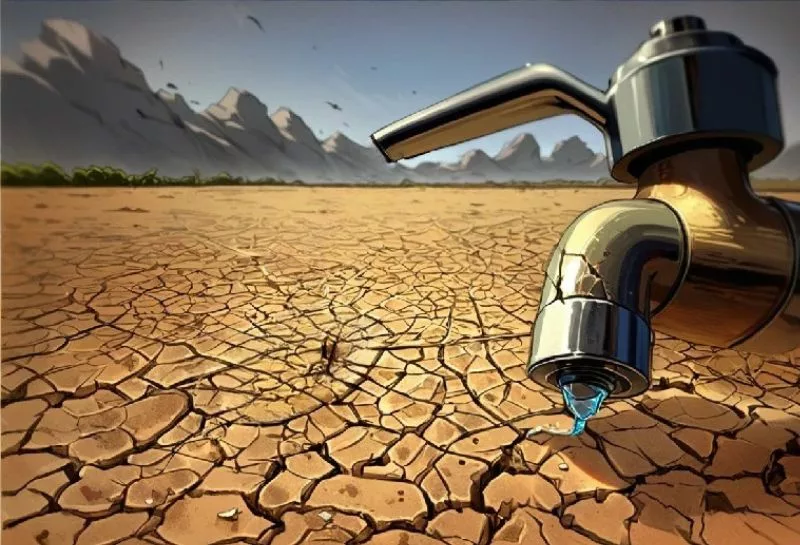
According to the Institute for Energy Research, mining consumes 500,000 gallons of water for one metric ton of Lithium. For example, let’s look at South America and Nevada:
- South America: Over half of Earth’s Lithium is within the Lithium Triangle. It’s a dry region that includes parts of Argentina, Bolivia, and Chile. Mining devours 65% of the Lithium Triangle’s water, hanging local farmers out to dry.
- Nevada: Evidence shows that Nevada’s Silver Peak Lithium Mine squanders almost 4 billion gallons of water yearly. Water sources dry out, while local cattle need that water to combat the searing desert sun.
The Howard Center highlights key concerns, including the US government’s failure to restrict the mine’s water usage. Instead, the federal government blindly approves mining contracts, refusing to consider environmental impacts.
3. Mineral Mining Erases Eco-Systems
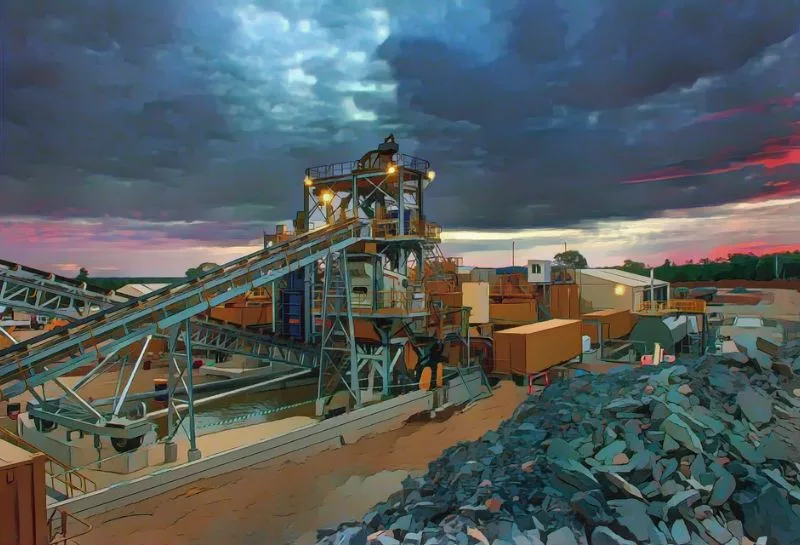
Mining minerals, including lithium, cobalt, and many other Li-ion ingredients, destroys local ecosystems. To illustrate, we’ll look at Tibet, Chile, and Nevada.
Terrible Tragedies in Tibet
Chinese-owned lithium mines are destroying Tibetan ecosystems. The mining process pollutes:
- Air infiltrated by dust, nitrogen oxides, sulfur dioxide, and carbon gas causes illness, respiratory failure, and climate change.
- Water with hydrochloric acid, arsenic, and other contaminants is deadly to drink.
- Soil becomes barren when mixed with toxic metals and chemicals from lithium mines.
Ganzizhou Rongda Lithium Mine: In May 2016, mass devastation plagued Tibet’s Liqi River. Specifically, chemicals from the nearby lithium mine poisoned the river’s vast aquatic ecosystem. Pictures surfaced showing hoards of dead fish floating downstream. Locals also reported seeing cow and yak carcasses.
However, this event was neither shocking nor unique. In fact, it was the third large-scale environmental incident:
- 2009: Locals report a chemical leak contaminating the river, killing livestock and fish.
- 2013: Damage due to a second event led to civil unrest. Protestors pleaded and Ganzizhou Rongda Lithium Mine closed.
- 2016: The mine reopens in April, and ecological devastation strikes in May.

Chilling Changes in Chile
Lithium mining in Chile is causing the Atacama salt flat to sink at a rate of 1 to 2 centimeters per year. Chile is the world’s second-largest lithium producer, and the Atacama Desert, where the salt flat is located, is home to arid-adapted plants. It is theorized that these plants will become crucial as the climate warms.
However, lithium extraction in this region pollutes the water, poisoning plants, animals, and people. When asked about Li-ion batteries in a 2009 interview, Guillermo Gonzalez, a lithium battery expert from the University of Chile, said:
Like any mining process, it is invasive, it scars the landscape, it destroys the water table and it pollutes the earth and the local wells.
Nature Neglected in Nevada
In Thacker Pass, Nevada, Lithium Americas mines an area described as “the last large sagebrush piece left for animals.” This mining operation will remove sagebrush and impact local wildlife.
Studies indicate that water pollution from the mine will exceed Nevada’s limits, with contamination by metals like antimony and arsenic. Nevada researchers have also found that these mines can harm fish up to 150 miles downstream. Globally, extractive industries like mining are responsible for 80% of species loss.
4. Battery Leaf Blowers Harm Humans
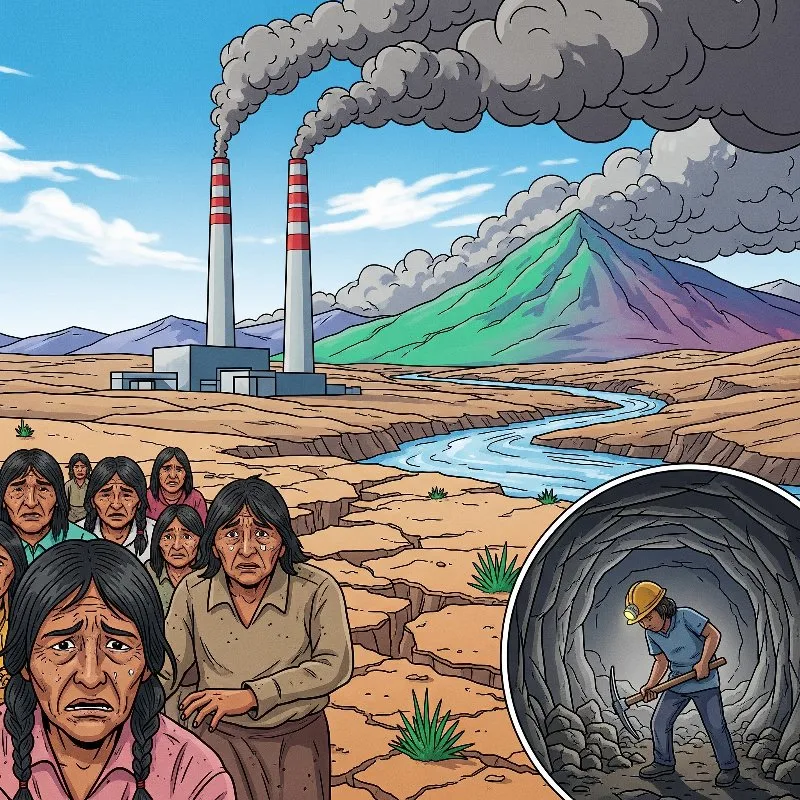
Lithium mining has significant human costs:
- Lithium Triangle (Chile, Argentina, and Bolivia): Hundreds of Indigenous people have been displaced from their ancestral lands, leading to protests in Chile and Bolivia. The loss of these communities, which possess vast knowledge of sustainable land management, could severely impact local ecosystems.
- Tibet: The Ganhetan industrial zone has seen increased rates of fluorosis, a disease that causes brittle teeth, linked to mining activities. A 2013 landslide at a mining site, due to poor safety standards, killed 83 miners.
- Democratic Republic of Congo and central Africa: The extraction of cobalt and nickel, also used in Li-ion batteries, is associated with harmful practices, including child labor without protective equipment. Children are basically enslaved in these 80% Chinese-owned mines.
5. Battery Leaf Blowers Create Woeful Waste
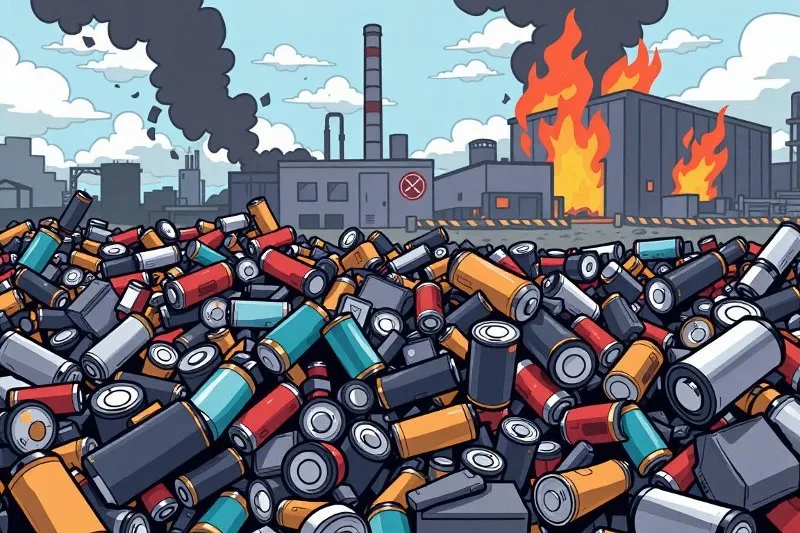
Improperly stored lithium-ion batteries can cause fires at recycling plants. The degradation of lithium cathodes over time also makes these batteries difficult to recycle. Furthermore, companies are often reluctant to disclose the composition of their batteries, and manufacturers have specific requirements for battery components, which further complicates the recycling process.
6. Leaf Blowers Blow Away Benefits

The forceful air from blowers stirs up dust, fine particulates, spores, pollen, mold, animal droppings, pesticide residues, and other contaminants. These particles stay suspended in the air for hours, posing a risk to respiratory health for both the operator and nearby residents.
Additionally, the intense force severely damages local ecosystems, especially those relying on the leaf litter layer:
- Destruction of Habitat: Leaves provide vital shelter for many beneficial insects, including pollinators like native bees (e.g., bumble bee queens) and butterflies (e.g., moth and butterfly pupae) that hide and lay eggs in the leaf litter. Blowing or shredding leaves often kills or removes these insects, disrupting their life cycles.
- Soil Degradation: Leaf litter naturally breaks down to return essential nutrients and organic matter to the soil, functioning as a free layer of compost. Removing the leaves strips the soil of this nutrient source. Additionally, the force of the blower can blow away protective topsoil and mulch, increasing the risk of soil erosion and compaction.
7. Li-ion Lobbies Lies

The primary justification for battery leaf blowers relies on a carefully managed comparison: the quiet, exhaust-free electric tool versus the noisy, smog-spewing two-stroke gas blower. It’s a comparison that appeals to well-intentioned consumers who want to reduce noise and local air pollution.
This narrative, however, is a victory of marketing over environmental science. The Li-ion lobby’s success depends on the public overlooking the profound, often irreversible, ecological damage outsourced across the globe.
The Profit-Driven Propaganda
The green electrification movement has channeled massive capital into a global supply chain dominated by foreign manufacturing. In fact, China controls over 80% of key Li-ion battery components.
This flow of money has occurred with minimal scrutiny, benefiting from the lower environmental and labor standards abroad. The lie perpetuated is that simply switching from gas to battery solves the problem. In reality, it just shifts the emissions and pollution from our neighborhood street to distant mining towns and coal-powered factories.
As noted in Section 1, over 60% of China’s electricity comes from coal. This means that a battery leaf blower touted as “zero-emission” is, in fact, built using a carbon-intensive process. The vast carbon debt incurred by the entire supply chain—from mining with heavy equipment to the final overseas freight—allows Li-ion companies to market a “clean” product while relying on highly polluting infrastructure.
A Better Way: The American-Made, High-Efficiency Alternative
The failure of the battery lobby is their refusal to acknowledge a path that offers a significantly lower total environmental cost: investing in and domestically manufacturing cleaner, high-efficiency four-stroke leaf blowers.
If the investment, subsidies, and consumer demand currently propping up the high-carbon global Li-ion supply chain were instead directed towards local, advanced 4-stroke engine technology, the environmental benefits would be substantial:
- Cleaner Manufacturing: Manufacturing in the United States leverages a significantly cleaner power grid than China’s (e.g., U.S. power relies on just 9% coal).
- Eliminating Freight Carbon: Domestic production entirely removes the unnecessary carbon footprint associated with shipping the final product thousands of miles across oceans.
- Strict Regulation: Products made on U.S. soil are subject to robust environmental, labor, and disposal regulations, ensuring that pollution is mitigated and worker rights are protected, avoiding the tragic outcomes seen in Tibet.
Two-stroke Vs. Four-Stroke Gas Leaf Blowers
The table below shows the results (stated in grams per minute) from an Edmunds emissions study comparing leafblowers with 2-stroke vs. 4-stroke engines.
| Echo PB-500T (2-stroke) | Ryobi RY09440 (4-stroke) |
| 6.445 CO | 3.714 CO |
| 0.010 NOx | 0.031 NOx |
| 1.495 NMHC | 0.182 NMHC |
The real sustainable choice is not just swapping one power source for another, but supporting a solution—the high-efficiency 4-stroke—that offers:
- Immediate air quality improvements
- Lower manufacturing footprint
- Domestic accountability.
Final Findings: Battery Leaf Blowers Are Bad for the Environment

Every leaf blower harms the environment. Thus, a rake is the most eco-friendly leaf removal tool. However, battery-powered and 2-stroke gas leaf blowers have the harshest environmental impact.
Unfortunately, America’s on the wrong track when it comes to going green. Instead of letting China lead in “clean” energy production, we should improve 4-stroke engine emissions and encourage American manufacturing. Additionally, we must promote accurate information and unbiased education.
Gas Vs. Battery Leaf Blowers
When comparing the environmental effects of gas vs. battery leaf blowers, the research is inconclusive. However, the table below summarizes my findings.
| Battery Blower (Li-ion) | 4-Stroke Gas Blower | |
| Working Environment | ✔ | ✗ |
| Global Carbon Footprint | ✗ | ✔ |
| Ecological Impact | ✗ | ✔ |
| Mother Earth | ✗ | ✔ |
Plundering Pollution with Further Research
The most glaring gap in the market is the lack of comparable, comprehensive Life Cycle Assessment (LCA) data that rigorously compares the total environmental toll of a battery blower against a high-efficiency 4-stroke engine manufactured in the U.S.
I urge policymakers and research institutions to focus funding on independent studies that specifically address these questions:
- Manufacturing Carbon Parity: At what point does the higher manufacturing carbon debt of a Li-ion blower (built on a high-carbon grid) finally equalize or surpass the lifetime operational emissions of a modern, well-maintained, domestically-made 4-stroke blower?
- Water Scarcity Cost: How should the enormous water consumption and ecological destruction caused by lithium mining (as seen in the Atacama and Nevada) be monetized and factored into the final environmental cost of the Li-ion product?
- The Domestic Advantage: Quantify the net reduction in global carbon emissions and toxic waste achieved by investing in and encouraging American-made 4-stroke engines built on a cleaner, lower-carbon U.S. electrical grid, compared to the current system of Asian Li-ion manufacturing and global shipping.
Only with unbiased data can we move past the lobbying and propaganda and make truly green decisions for a healthier planet.
How Can a Homeowner Help?
For the average homeowner, the message is simple: the most eco-friendly tool for your leaves is still a rake. If you must use a blower for a large property, a well-maintained, American-made 4-stroke model currently has a stronger case for being the lesser of two evils.
FAQ About Battery Leaf Blowers

1. How much lithium is in a leaf blower battery?
A typical leaf blower battery contents 1 to 2 grams of lithium.
To calculate the approximate amount of lithium in a leaf blower battery, use the formula below.
(mAh / 1,000) * 0.3 = grams of lithium
To convert Ah to mAh, use the next formula.
1 Ah = 1,000 mAh
Let’s say the leaf blower runs on a 5 Ah battery:
5 Ah = 5,000 mAh
(5,000 mAh / 1,000) * 0.3 = 1.5 grams
2. Are electric leaf blowers worth it?
To figure out the value of a electric leaf blowers, consider:
- Cost: Corded electric leaf blowers are the most affordable for light-duty leaf removal and gas leaf blowers are the best value for heavy debris. Battery-powered leaf blowers give the least bang for your buck.
- Potency: The strength of a leaf blower depends on MPH and CFM. The most potent handheld leaf blowers run on batteries and the most powerful backpack models run on gas. When comparing backpack vs. handheld leaf blowers, it’s easier to carry the weight on your back.
- Convenience: Battery-powered leaf blowers are the most convenient.
3. What are the best 4-stroke leaf blowers?
The Senix BLV4QL-M is my favorite 4-stroke handheld and the Makita EB5300TH is the best 4-stroke backpack blower.
4. How can proper maintenance reduce emissions from a 4-stroke leaf blower?
“Keeping a 4-stroke leaf blower maintained (e.g., fuel filter, oil changes) keeps contaminants out of the combustion chamber. Otherwise, once ignited, these contaminants can cause harmful emissions. Also, they can lead to premature piston ring wear, resulting in oil from the crankcase getting into the combustion chamber. When oil burns it causes harmful emissions as well,” explains Jeff Yochum, lead maintenance tech at Ring Container Technologies.
About the Author: Shelly Selzer
Shelly Selzer is an independent researcher and technical content expert with over 20 years of experience in complex content creation. The last five years of he career focused on Outdoor Power Equipment (OPE) analysis.
Shelly’s work is defined by an uncompromising commitment to empirical research and the facts—a commitment which led her to leave corporate publishing. This article is the result of her dedication to providing consumers with the full, unvarnished environmental truth that commercially-driven content often obscures.
Support Independent Research
Support Shelly by joining her Patreon Army. Your support keeps this blog independent and ad-free, funding the rigorous research needed to publish the truth that corporate content often obscures.
All images were created using generative AI tools, specifically Canva’s Magic Studio and Fotor’s AI Image Generator, with human creative direction and editing.
